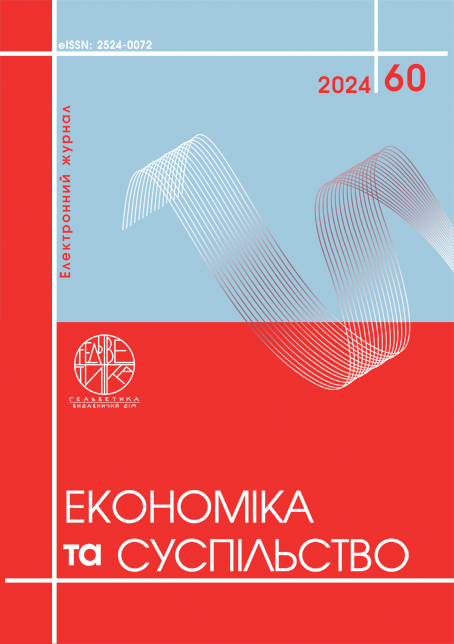DIGITAL SUPPORT AS A FORMING FACTOR OF INNOVATIVE COMMUNITIES IN THE CONDITIONS OF SECURITY-ORIENTED SUSTAINABLE DEVELOPMENT OF ENTERPRISES IN UKRAINE
Abstract
In the current military conditions, the problem of combining human intelligence and the capabilities of information and computer technologies is more relevant than ever. Such interaction will allow to create self-managed innovative communities, which provide for the coordinated interaction of business, authorities and the population. The work established that the increase in the competitiveness of innovative communities under the influence of digitalization will not happen as quickly as we would like. This is due to the fact that for the efficient operation of the system under the influence of the fourth industrial revolution, time is needed for its adaptation to the new order. And furthermore, the benefits of digital services do not have a market value and are not captured in overall performance and performance assessments. The work considers a new criterion according to which the population is grouped depending on its attitude and the possibilities of using the latest research in the field of technology - the socio-technographic factor of segmentation. It has been determined what potential benefits business entities can receive from the implementation of Industry 4.0 technologies. It has been determined which 4.0 technologies are relevant today. It is indicated what steps should be taken by authorities and business entities for the development of innovative communities. They have been ranked. It has been established that the general increase in the level of technological capability will have an effective result only when the majority of the population has access to the latest technologies.
References
Kuybida V.S., Karpenko O.V., Namestnik V.V. (2020) Tsyfrove vriaduvannia v Ukraini: bazovi definitsii poniatiino-katehorialnoho aparatu [Digital governance in Ukraine: basic definitions of the conceptual and categorical apparatus]. Visnyk Natsionalnoi akademii derzhavnoho upravlinnia pry Prezydentovi Ukrainy – Bulletin of the National Academy of Public Administration under the President of Ukraine. Vol. 1. pp. 5–10.
Strutynska I. V. (2019) Definitsii poniattia «Tsyfrova transformatsiia» [Definitions of the term "Digital transformation"]. Prychornomorski ekonomichni studii – Black Sea economic studies. Vol. 48, Part. 2. pp. 91–96.
Tymoshenko, N., & Shabanova, M. (2021). Rozvytok innovatsiynoyi diyalʹnosti v umovakh tsyfrovizatsiyi [Development of innovative activity in conditions of digitalization]. Ekonomika ta suspilstvo – Economy and society, (29). DOI: https://doi.org/10.32782/2524-0072/2021-29-30
Anthony S., Eyring M., Gibson L. (2006) Mapping Your Innovation Strategy. Harvard Business Review. May. URL: http://hbr.org/2006/05/mapping-your-innovationstrategy/ar/1 (дата звернення 23.05.2023).
Ariel Ezrachi, Maurice E. Stucke Digitalisation and its impact on innovation URL: https://ec.europa.eu/info/publications/digitalisation-and-its-impact-innovation_en (the date of application: 01.04.2023).
Bowonder B., Mani S. (2002). Venture Capital and Innovation : The Indian Experience. International Conference on the theme jointly organized by UNU/INTECH and EU-DG Research. 7-8 November 2002. Brussels. Belgium.
Cassiman B., Valentini G. (2016) Open innovation: Are inbound and outbound knowledge flows really complementary? Strategic Management Journal. № 37. рр. 1034-1046.
Chesbrough, H., Bogers M. (2014) Explicating open innovation: Clarifying an emerging paradigm for understanding innovation. New frontiers in open innovation / In H. Chesbrough, W. Vanhaverbeke, & J. West (Eds.). Oxford : Oxford University Press, Р. 3–28.
Dougherty D. (2017) Organizing for innovation in complex innovation systems. Innovation. №19:1, рр. 11–15.
Robert D. Hisrich, Michael P. Peters, Dean A. (2020). Shepherd Entrepreneurship McGraw-Hill, 579 p.
Stalyi tsyfrovyi rozvytok – pershi pidsumky opytuvannia [Sustainable digital development - the first results of the survey]. URL: https://industry4-0-ukraine.com.ua/2019/05/14/сталий-цифровий-розвиток-перші-підс/ (дата звернення 12.03.2023).
Куйбіда В.С., Карпенко О.В., Наместнік В.В. Цифрове врядування в Україні: базові дефініції понятійно-категоріального апарату. Вісник Національної академії державного управління при Президентові України. 2020. № 1. С. 5–10.
Струтинська І. В. Дефініції поняття «Цифрова трансформація». Причорноморські економічні студії : науковий журнал. 2019. Вип. 48, Ч. 2. С. 91–96.
Тимошенко, Н., & Шабанова, М. Розвиток інноваційної діяльності в умовах цифровізації. Економіка та суспільство, 2021, 29. DOI: https://doi.org/10.32782/2524-0072/2021-29-30
Anthony S., Eyring M., Gibson L. Mapping Your Innovation Strategy. Harvard Business Review. May 2006. URL: http://hbr.org/2006/05/mapping-your-innovationstrategy/ar/1 (дата звернення 23.05.2023).
Ariel Ezrachi, Maurice E. Stucke Digitalisation and its impact on innovation URL: https://ec.europa.eu/info/publications/digitalisation-and-its-impact-innovation_en (the date of application: 01.04.2023).
Bowonder B., Mani S. Venture Capital and Innovation : The Indian Experience. International Conference on the theme jointly organized by UNU/INTECH and EU-DG Research. 7-8 November 2002. Brussels. Belgium, 2002.
Cassiman B., Valentini G. Open innovation: Are inbound and outbound knowledge flows really complementary? Strategic Management Journal, 2016. № 37. Р. 1034-1046.
Chesbrough, H., Bogers M. Explicating open innovation: Clarifying an emerging paradigm for understanding innovation. New frontiers in open innovation / In H. Chesbrough, W. Vanhaverbeke, & J. West (Eds.). Oxford : Oxford University Press, 2014. Р. 3–28.
Dougherty D. Organizing for innovation in complex innovation systems. Innovation. 2017. №19:1. Р. 11–15.
Robert D. Hisrich, Michael P. Peters, Dean A. Shepherd Entrepreneurship McGraw-Hill, 2020. 579 p.
Сталий цифровий розвиток – перші підсумки опитування. URL: https://industry4-0-ukraine.com.ua/2019/05/14/сталий-цифровий-розвиток-перші-підс/ (дата звернення 12.03.2023).

This work is licensed under a Creative Commons Attribution 4.0 International License.


